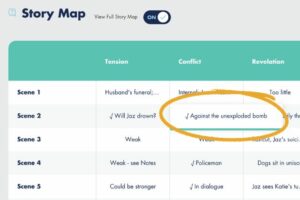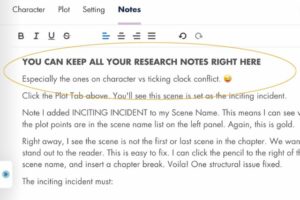Conflict is a writer’s bread and butter in storytelling. It’s what readers read for. They want to see your characters struggle to achieve their goals. If there’s no conflict in your story… then readers will bin your books in favour of someone else’s. There are 5 major types of conflict in fiction you need to know about, my writerly friend.
And one of those conflict types is character vs ticking clock conflict.
This type of conflict is so popular because everyone knows what it feels like to be in a race against time.
And that’s great… but how does this type of conflict work, and how can you use it to engage readers?
Excellent question.
I used to find writing conflict difficult… like, hair-pulling difficult. Did I have enough conflict in my books? Was that conflict strong enough? Had I done it right? I spent ages pouring over my early manuscripts deciding whether the conflict there was good enough…
Until I found the Fictionary Software. One of the 38 Story Elements Fictionary teaches you to use is conflict and, using the Story Map Visual Insight, you can easily track your use of Conflict throughout your novel.
Talk about a game-changer.
And character vs ticking clock conflict is no different. You can track that too.
So, let’s delves in to what this kind of conflict is, and how you can use it to keep your readers flipping pages into the early hours.
What is Character vs Ticking Clock Conflict (AKA Man vs Ticking Clock or Person vs Ticking Clock Conflict)?
Ask yourself: Do I understand what character vs ticking clock conflict is?
Conflict happens when you place your characters in direct opposition to something (or someone else). Character vs ticking clock conflict happens when your protagonist (main character) is fighting tooth-and-nail against time. In these types of stories, the antagonist (villain) is not a person.
Time itself becomes the antagonist.
In other words, you place a ticking clock between your protagonist (or major side characters) and what they want. When you give your protagonist less time than they think they need to find/kill/complete something, you create heightened tension and conflict.
We’ll go into specific examples from fiction later, but character vs ticking clock conflicts often see your characters battling against:
- Deadlines
- Timed explosives
- Magical Time Limits
- Ultimatums
- And more…
NOTE: You might see people refer to character vs ticking clock conflict as man vs ticking clock conflict. In this context, it doesn’t relate to male characters, but to humanity. People also refer to it as person vs. ticking clock conflict. I’ll be using all three terms throughout this article.
Action: Every time you use this type of conflict in your story, make a note of the ticking clock that’s causing the conflict, and whether you think the conflict is strong enough. If you’re using the Fictionary Software, it’s easy to track your conflict usage using the Story Map Visual Insight. You’ll be able to see the conflict you’ve used in every scene at a glance, and work out whether it best serves your story.

Why Person vs Ticking Clock is a Fantastic Type of External Conflict
Ask yourself: Do I understand why character vs ticking clock conflict is so powerful?
Remember, external conflict (conflict that happens outside a character) is when an antagonist—or antagonistic force—places obstacles in the way of your characters achieving their goals. In other words, the antagonist or antagonistic force causes problems for your protagonist and major side characters.
Now, think about when you only have a limited time to do something, and all the problems that can cause in your everyday life.
How frustrating is it when you need to get to work, but you left the house late? How annoyed do you get when you’ve spent ages writing an essay, you’re about to email it to your tutor (right on the deadline), and your computer crashes? And isn’t it anger-making when you need to meet a friend at a certain time, and something delays your train?
In each of these scenarios, a ticking clock causes a problem, which makes it harder for us to achieve our external goals.
And that’s part of the reason character vs ticking clock conflict is so powerful.
It’s a universal human experience.
We all know what it’s like to go head-to-head with time and lose. Your readers know how this feels too, so they’ll sympathise with your characters when man vs ticking clock conflict stops them from getting what they want.
Action: Learn as much as you can about character vs ticking clock conflict before you write your story, and keep notes on the discoveries you make. If you’re using the Fictionary Software, you can use the Notes panel next to each scene to keep all your research notes in one place and reference them easily.

Examples of Man vs Ticking Clock Conflict in Fiction
The best way to learn about a conflict type is to analyse examples from fiction and see how other authors do it. Luckily, there are plenty of character vs ticking clock conflict novels we can use for this exact purpose.
Let’s look at three popular examples of person vs ticking clock conflict in fiction.
The Da Vinci Code by Dan Brown
In The Da Vinci Code by Dan Brown the protagonist, Robert Langdon, faces a ticking clock when he sets out to find the Holy Grail before Opus Dei, the shadowy organisation opposing him.
Throughout the novel, Langdon is in a race against time to find the Grail before Opus Dei, and they will stop at nothing to get what they want. The only way Langdon can achieve his story goal is if he finds the Grail before them.
The ticking clock is a common plot device used to create tension and conflict in thrillers.
Cinderella by The Brothers Grimm
In Cinderella by The Brothers Grimm the protagonist, Cinderella, faces a ticking clock when she attends the ball.
When the Fairy Godmother transforms Cinderella into a princess so she can enjoy the ball and catch the prince’s attention, she warns her the spell will wear off at midnight. This means Cinderella has a limited time to do both these things.
When the spell runs out, Cinderella flees the ball, and her dress and coach disappear, and she’s no longer a princess.
Timeline by Michael Crichton
In Timeline by Michael Crichton the combined protagonist, Chris Hughes and Kate Erickson, face a ticking clock when their professor gets trapped in the past.
The character vs ticking clock conflict emerges when Chris, Kate, and the other affected students discover they only have 37 hours to save their professor.
If they can’t save him, he’ll be stuck in the past forever.

Conclusion: Character vs Ticking Clock Conflict
There you have it, folks.
Mastering the art of character vs. ticking clock conflict can transform your story into one readers will love. This type of conflict, when done well, creates stories that will have readers pulling their hair out because everything is so darn tense.
It’s a potent weapon in your writerly toolbox, but like any tool, you’ve got to know how to weild it.
That’s where Fictionary Software comes in.
This nifty tool helps you map out your conflict, ensuring it’s a wild roller coaster ride that keeps readers glued to your pages. And the best part? You don’t have to take my word for it. You can try it out for yourself, absolutely free.
Take a 7-day free trial of Fictionary Software.


